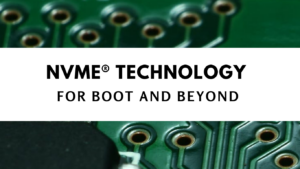
NVMe® Technology for Boot and Beyond
BlogBy James Gomez, Deepak Kurien and Rohit Gupta, Western Digital
In this blog we will look at how NVM Express® (NVMe®) SSDs are replacing SATA SSDs as enterprise boot drives. We will then discuss how NVMe SSDs can be utilized to support additional workloads beyond the typical OS boot process.
The strategic value of enterprise datacenters
Data is a strategic asset for many established and new businesses, consistently adding financial value, increasing competitive advantage, and opening new growth opportunities. To run complex algorithms, transform data, and obtain actionable intelligence, businesses rely on enterprise datacenters, public or private cloud, on-premises infrastructure, and hosted or co-located datacenters. The consistent growth in data infrastructure and, therefore, higher capital expenditure on enterprise datacenters is pushing businesses to achieve higher utilization and efficiency. This necessitates the need for storage devices, including boot and storage SSDs, to do more.
Boot storage drives and form factors
Boot only SSDs were designed to support a single host operating system. They typically are low endurance, low power (5W or below), have no power loss protection, and are in the M.2 form factor. SATA SSDs have been adequate for boot only use cases; however, if you want to do additional workloads, you will need to upgrade.
NVMe SSDs for boot and beyond play a role in increasing enterprise datacenter efficiency and utilization by enabling boot and beyond. Boot and beyond drives can support multi-operating systems for physical and/or virtual machines. They can store system/program files and allow application and system logs, paging/swapping, and journaling. Since Boot and beyond drives need to support mixed workloads, they generally have higher endurance, higher average capacities, and may consume more power than SATA SSDs. Most enterprise systems need to save the last known system state to restore the machines and programs thus require a power loss protection feature. The NVMe Boot and beyond SSDs are available in M.2 and U.2 form factors and are likely to add more form factors in the future.
Since Boot and beyond drives run on NVMe protocol on PCI Express® (PCIe®) interface, systems can share PCIe lanes and leverage rich NVMe technology features such as performance, submission/completion queues, QoS, arbitration mechanisms, and management interface for various device configurations. Because of these advantages, NVMe architecture is likely to converge as the common solution for Boot and beyond solutions and further accelerate the transition from SATA to PCIe technology.
Conclusion
Enterprise datacenters are continuously evolving to improve storage utilization, leverage protocols and interfaces, and consolidate drives wherever possible to lower the overall TCO. NVMe SSDs meet and exceed the expectations for boot and beyond use cases. The ability for NVMe SSDs to support both boot and enable other applications makes NVMe the right choice to transition away from SATA boot only drives to NVMe SSDs on PCIe interface for current and next-generation datacenters.
About the Authors
Rohit Gupta has more than 15 years of compute & storage industry experience in various capacities of increasing cross functional responsibilities. At Western Digital, he is responsible for Datacenter Segment Marketing for eSSD products.
Deepak Kurien is a Marketing Manager in the Enterprise and Datacenter division at Western Digital. As a 12 year veteran, Deepak has a diverse software and hardware background and has held various positions in product management, marketing and corporate pricing.
James Gomez is a product marketing professional with Western Digital’s Enterprise SSD team. He has over seven years of working experience in the automotive and storage industries, holding various roles in product development and marketing.